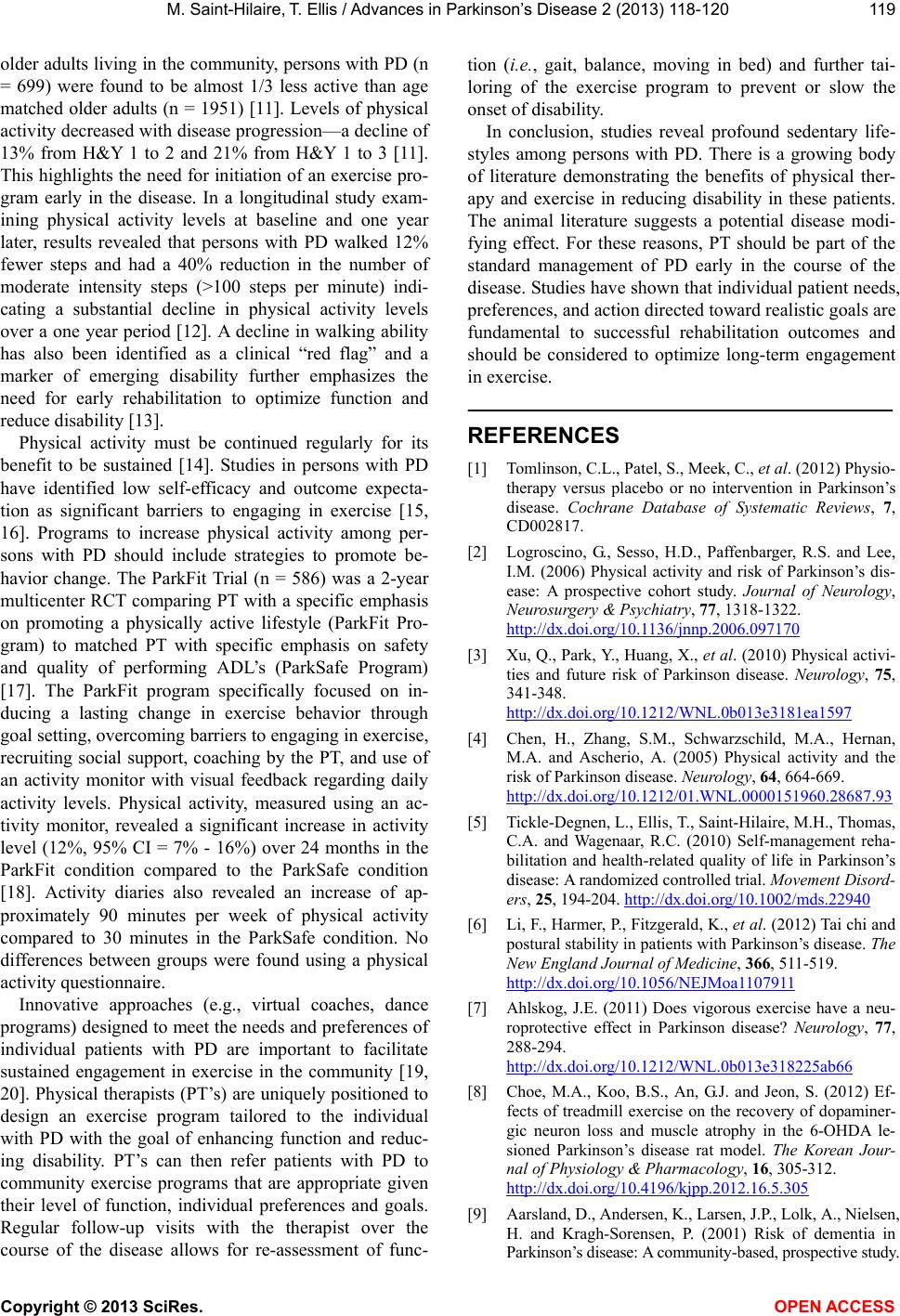
M. Saint-Hilaire,T. Ellis / Advances in Parkinson’s Disease 2 (2013) 118-120 119
older adults living in the co mmunity, persons with PD (n
= 699) were found to be almost 1/3 less active than age
matched older adults (n = 1951) [11]. Levels of physical
activity decreased with d isease progression—a decline of
13% from H&Y 1 to 2 and 21% from H&Y 1 to 3 [11].
This highlights the need for initiation of an exercise pro-
gram early in the disease. In a longitudinal study exam-
ining physical activity levels at baseline and one year
later, results revealed that persons with PD walked 12%
fewer steps and had a 40% reduction in the number of
moderate intensity steps (>100 steps per minute) indi-
cating a substantial decline in physical activity levels
over a one year period [12]. A decline in walking ability
has also been identified as a clinical “red flag” and a
marker of emerging disability further emphasizes the
need for early rehabilitation to optimize function and
reduce disability [13].
Physical activity must be continued regularly for its
benefit to be sustained [14]. Studies in persons with PD
have identified low self-efficacy and outcome expecta-
tion as significant barriers to engaging in exercise [15,
16]. Programs to increase physical activity among per-
sons with PD should include strategies to promote be-
havior change. The ParkFit Trial (n = 586) was a 2-year
multicenter RCT comparing PT with a specific emphasis
on promoting a physically active lifestyle (ParkFit Pro-
gram) to matched PT with specific emphasis on safety
and quality of performing ADL’s (ParkSafe Program)
[17]. The ParkFit program specifically focused on in-
ducing a lasting change in exercise behavior through
goal setting, overcoming barriers to engaging in exercise,
recruiting social support, coaching by the PT, and use of
an activity monitor with visual feedback regarding daily
activity levels. Physical activity, measured using an ac-
tivity monitor, revealed a significant increase in activity
level (12%, 95% CI = 7% - 16%) over 24 months in the
ParkFit condition compared to the ParkSafe condition
[18]. Activity diaries also revealed an increase of ap-
proximately 90 minutes per week of physical activity
compared to 30 minutes in the ParkSafe condition. No
differences between groups were found using a physical
activity questionnaire.
Innovative approaches (e.g., virtual coaches, dance
programs) designed to meet the needs and preferences of
individual patients with PD are important to facilitate
sustained engagement in exercise in the community [19,
20]. Physical therapists (PT’s) are uniquely positioned to
design an exercise program tailored to the individual
with PD with the goal of enhancing function and reduc-
ing disability. PT’s can then refer patients with PD to
community exercise programs that are appropriate given
their level of function, individual preferences and goals.
Regular follow-up visits with the therapist over the
course of the disease allows for re-assessment of func-
tion (i.e., gait, balance, moving in bed) and further tai-
loring of the exercise program to prevent or slow the
onset of disability.
In conclusion, studies reveal profound sedentary life-
styles among persons with PD. There is a growing body
of literature demonstrating the benefits of physical ther-
apy and exercise in reducing disability in these patients.
The animal literature suggests a potential disease modi-
fying effect. For these reasons, PT should be part of the
standard management of PD early in the course of the
disease. Studies have shown that individual patient needs,
preferences, and action directed toward realistic goals are
fundamental to successful rehabilitation outcomes and
should be considered to optimize long-term engagement
in exercise.
REFERENCES
[1] Tomlin son, C.L., Patel, S., Meek, C., et al. (2012) Physio-
therapy versus placebo or no intervention in Parkinson’s
disease. Cochrane Database of Systematic Reviews, 7,
CD002817.
[2] Logroscino, G., Sesso, H.D., Paffenbarger, R.S. and Lee,
I.M. (2006) Physical activity and risk of Parkinson’s dis-
ease: A prospective cohort study. Journal of Neurology,
Neurosurgery & Psychiatry, 77, 1318-1322.
http://dx.doi.org/10.1136/jnnp.2006.097170
[3] Xu, Q., Park, Y., Huang, X., et al. (2010) Physical activi-
ties and future risk of Parkinson disease. Neurology, 75,
341-348.
http://dx.doi.org/10.1212/WNL.0b013e3181ea1597
[4] Chen, H., Zhang, S.M., Schwarzschild, M.A., Hernan,
M.A. and Ascherio, A. (2005) Physical activity and the
risk of Parkinson disease. Neurology, 64, 664-669.
http://dx.doi.org/10.1212/01.WNL.0000151960.28687.93
[5] Tickle-Degnen, L., Ellis, T., Saint-Hilaire, M.H., Thomas,
C.A. and Wagenaar, R.C. (2010) Self-management reha-
bilitation and health-related quality of life in Parkinson’s
disease: A randomized controlled trial. Movement Disord-
ers, 25, 194-204. http://dx.doi.org/10.1002/mds.22940
[6] Li, F., Harmer, P., Fitzgerald, K., et al. (2012) Tai chi and
postural stability in patients with Parkinson’s disease. The
New England Journal of Medicine, 366, 511-519.
http://dx.doi.org/10.1056/NEJMoa1107911
[7] Ahlskog, J.E. (2011) Does vigorous exercise have a neu-
roprotective effect in Parkinson disease? Neurology, 77,
288-294.
http://dx.doi.org/10.1212/WNL.0b013e318225ab66
[8] Choe, M.A., Koo, B.S., An, G.J. and Jeon, S. (2012) Ef-
fects of treadmill exercise on the recovery of dopaminer-
gic neuron loss and muscle atrophy in the 6-OHDA le-
sioned Parkinson’s disease rat model. The Korean Jour-
nal of Physiology & Pharmacology, 16, 305-312.
http://dx.doi.org/10.4196/kjpp.2012.16.5.305
[9] Aarsland, D., Andersen, K., Larsen, J.P., Lolk, A., Nielsen,
H. and Kragh-Sorensen, P. (2001) Risk of dementia in
Parkinson’s disease: A community-based, prospective study.
Copyright © 2013 SciRes. OPEN A CCESS